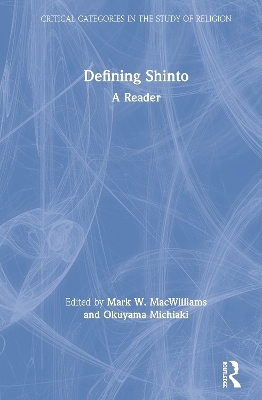
Defining Shinto
Acumen Publishing Ltd (Verlag)
978-1-84465-837-4 (ISBN)
- Titel z.Zt. nicht lieferbar
- Versandkostenfrei
- Auch auf Rechnung
- Artikel merken
"Shinto" is one of the most contested categories in the field of Japanese religious studies. While the term "Shinto" has a long history in the pre-modern period, this volume focuses on how the term has evolved in modern Japan. Divided into five parts, the book covers:
Shinto and the modern Japanese nation state
Pre-war Japanese intellectuals on Shinto
Shinto and ultra-nationalism of the 1930s and 1940s
Post-war reforms and reformulations
Contemporary ways of defining Shinto
Presenting a wealth of documents, most of which have been translated here for the first time, the book is an invaluable resource for scholars and students of Japanese religion.
Mark W. MacWilliams is Professor of Religious Studies at St. Lawrence University, USA, and has published widely in the field of Japanese religions. Okuyama Michiaki is Research Fellow at the Nanzan Institute of Religion and Culture and Professor at the Faculty of Humanities at Nanzan University, Japan. He has written extensively on the concept of Shinto in the light of studies on comparative religion.
Introduction: defining Shinto in modern Japan
Parts 1 and 2: Introduction
PART 1
Shinto and the modern Japanese nation state: Official documents concerning Shinto and shrine administration 41
1 Proclamation concerning the restoration of the Council of Divinities (March 13, 1868)
2 Ordinance distinguishing divine and Buddhist matters, proclamation issued by the Council of State (March 28, 1868)
3 Imperial rescript for the promulgation of the Great Teachings (January 3, 1870)
4 Official notice issued by the Council of State—shrine rituals as a state religious practice (May 14, 1871)
5 Notification issued by the Council of State—the principal aim of the Great Teachings (July 4, 1871)
6 Three articles for teaching issued by the Ministry of Public Instruction (April 28, 1872)
7 Notification [regarding Yasukuni Shrine] issued by the Council of State. Issued with the Home Ministry and the Ministries of the Army, Navy, and Tokyo Prefecture (June 4, 1879)
8 Notification (no.1 in the fourth category) issued by the Home Ministry (January 24, 1882)
9 Notification (no. 30 in the second category) issued by the Home Ministry (May 15, 1882)
10 Notification (no. 19) issued by the Council of State (August 11, 1884)
11 The Constitution of the Empire of Japan—imperial oath at the sanctuary of the Imperial Palace, and Articles 1–3, and 28 (February 11, 1889)
12 Imperial edict (no. 220) on the disposition of vacant properties after the consolidation of shrines, temples, or Buddhist halls (August 10, 1906)
13 Dates of important subsequent ordinances issued by the Japanese imperial state
14 Imperial edict (no. 736) on the official institutionalization of the Board of Divinities (Jingiin) (November 9, 1940)
PART 2
Pre-war Japanese intellectuals on Shinto
15 KUME KUNITAKE
Shinto as the ancient custom of worshipping heaven (1891)
16 KAWAKAMI HAJIME
Japan’s unique form of nationalism (1911)
17 YANAGITA KUNIO
My view of Shinto (1918)
18 KATŌ GENCHI
Shinto, a religion of the theanthropic type, as distinguished from a religion of the theocratic type and Shinto as a national religion, not entirely devoid of a universal aspect and remarkably tolerant (1935)
19 TSUDA SŌKICHI
The various meanings of the word Shinto (1937–39)
SUGGESTED READINGS (PARTS 1 AND 2)
PART 3
Shinto and ultra-nationalism in the 1930s and 1940s
Introduction
20 KŌNO SEIZŌ
Kannagara no michi (The way of kannagara, 1940)
21 MINISTRY OF EDUCATION (MONBUSHŌ)
The inherent character of the people and ceremonial rites and morality, from Kokutai no hongi (The Cardinal Principles of the National Polity, 1937)
22 MINISTRY OF EDUCATION (MONBUSHŌ)
Practicing the way of imperial subjects, from Shinmin no michi (The Way of Subjects, 1941)
23 THE BOARD OF DIVINITIES (JINGIIN)
National polity and the great way of the gods, national history and shrines, and the state and shrines, from Chapter 1, National Polity and Shrines from the Jinja hongi (The Cardinal Principles of Shrines, 1944)
SUGGESTED READINGS
PART 4
Recasting Shinto—Post-war reforms and reformulations
Introduction
24 GENERAL HEADQUARTERS, SUPREME COMMANDER FOR THE ALLIED POWERS 207
The Shinto Directive (December 15, 1945)
25 ORIKUCHI SHINOBU
A new direction for Shinto (1949)
26 WATSUJI TETSURŌ
Feudal thought and Shinto doctrine (1945) and Representative of the whole people (1948)
27 ASHIZU UZUHIKO
The various issues related to contemporary shrines (1951)
28 MURAKAMI SHIGEYOSHI
The emperor as a deity in human form and the development of imperial house rites (1977)
29 KURODA TOSHIO
Shinto in the history of Japanese religion (1981)
SUGGESTED READINGS
PART 5
Contemporary ways of defining Shinto
Introduction
30 MIYATA NOBORU
State Shinto (1999)
UEDA KENJI
The structure of Shinto faith (1995)
32 SONODA MINORU
Our way of shrines and Shinto, Asking about what shrine Shinto will look like in the future, The local shrine grove—a Shinto model of one’s home, and Shrines and Shinto (1998)
33 KAMATA TŌJI
What is Shinto? (1999)
34 INOUE HIROSHI
Introduction and A syncretism based upon differentiation—the formation of ‘Shinto’ (2011)
SUGGESTED READINGS
| Reihe/Serie | Critical Categories in the Study of Religion |
|---|---|
| Zusatzinfo | 3 Tables, black and white |
| Verlagsort | Durham |
| Sprache | englisch |
| Maße | 174 x 246 mm |
| Gewicht | 900 g |
| Themenwelt | Geisteswissenschaften ► Religion / Theologie ► Weitere Religionen |
| ISBN-10 | 1-84465-837-6 / 1844658376 |
| ISBN-13 | 978-1-84465-837-4 / 9781844658374 |
| Zustand | Neuware |
| Haben Sie eine Frage zum Produkt? |
aus dem Bereich


